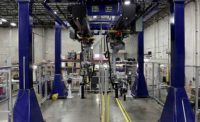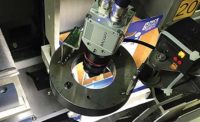In nearly every workplace, multitasking is a required skill. A person must be able to wear many hats, so to speak, and successfully handle several ongoing assignments or projects. This same ability is now expected of robots.
“Manufacturers’ need for their robots to be increasingly flexible has driven most of the development and improvement in tool changers over the last decade,” explains Dan Merritt, senior applications engineer for ATI Industrial Automation. “In industries from automotive to white goods, robots can handle more-demanding applications than ever thanks to robust tool changers.”
Earlier this year, Electroimpact began using ATI tool changers with its Integrated Structural Assembly of Advanced Composites (ISAAC) system for NASA. The automated system consists of a modified KUKA industrial robot and a large, rotating, disk-like end-effector that is loaded with up to 16 spools of carbon fiber ribbon.
A tool changer in the head of the end-effector allows it to be automatically detached and replaced with an identical end-effector loaded with different tools. This enables NASA to quickly change over to another job.
Many other assembly systems require just as much versatility from their robots to optimize cost-effectiveness and throughput. After all, companies purchase state-of-the art robots for their technological capabilities, not downtime. With the right tool changer, a robot can be more productive in every application and move well beyond doing one simple task ad infinitum.
Two Sides to Success
When robots began appearing in factories in the 1960s and 1970s, application-specific end-of-arm tooling (EOAT) was made by robot companies or integrators and bolted directly onto the end of a robot arm. Unfortunately, whenever the robot needed to perform a new assembly task, different application-specific EOAT was attached. In addition, this early tooling was large, bulky and didn’t work very well. However, the ability to switch out tooling did slowly improve.
In the mid-1980s, General Motors designed the RHC series of pneumatic tool changers that were manufactured by Robohand. Gary Labadie, global product director for grippers at
DESTACO, says the four-model series is still used in GM plants throughout the world to quicken assembly of all types of vehicles. The changers handle tooling for welding and assembling parts of all sizes and have a payload capacity of 20, 130, 300 or 1,000 pounds.
By the late 1980s, specialty tool-changer suppliers entered the marketplace. This development, in conjunction with manufacturers’ need for robot flexibility, has led to major improvements in tool changers over the last 25 years.
“With today’s tool changers, EOAT can usually be switched out within seconds,” notes Matthew Smith, automation applications engineer for SCHUNK. “To manually change the tooling could take up to 30 minutes for even an experienced operator.”
A tool changer consists of two components: a robot, or master, side that is attached to the robotic arm; and a tool-side piece that is attached to the end-effector. During a tool change, both components are automatically or manually coupled. This coupling takes just a few seconds. Various failsafe mechanisms ensure that the pieces stay together in the event of lost air pressure or electricity.
All tool changers have a similar locking mechanism. It involves a manually or pneumatically driven piston or electric motor forcing a set of balls into a groove in the tool-side piece to lock it in place and clamp the two pieces together using guide pins or locking pins.
William Shelley, sales representative for Kosmek USA Ltd., says the company’s SWR pneumatic tool changers feature dual contact surface resting. This technology has a movable tapered sleeve that eliminates gaps in the sleeves and ball-lock areas, enabling mating with very high precision and zero clearance. The design also creates a rigid connection with zero backlash.
DESTACO uses rollers rather than balls in its RQC series to ensure a strong connection. According to Labadie, the rollers provide full contact rather than just point contact as with balls. This larger surface area provides a very strong and stiff coupling.
“The approach of the robot to the end-effector for coupling should take several seconds,” according to Dan Peretz, vice president for North America at IPR Robotics Inc. “If the robot approaches too fast, proper coupling may not occur. This leads to the possibility of tooling falling off, which is very dangerous.”
Jim Geary, a senior product engineer for DESTACO, agrees. He says reliable tool changer coupling is more important than ever in light of the growing presence of collaborative robots on the assembly line.
To ensure worker safety, a workcell’s control system should include sensors that monitor when the tool changer is in the locked or unlocked position. This information is displayed on an HMI or a monitor connected to a PLC.
Kosmek’s SWR series has an LED light that indicates when a robot is not close enough to an end-effector for proper
coupling. Luke Matsuda, sales representative for Kosmek, says this light is red when the two sides are more than 2 millimeters apart. The light turns green when both sides are mated and the check port closes the air sensor.
A tool changer comes in various shapes, including round, semi-round (with one or two flat sides), square, triangular and hexagonal. Its body is usually made of high-grade anodized aluminum, whereas the locking components are made of hardened stainless steel. Aluminum keeps the changer fairly lightweight, so it doesn’t take away too much load capacity from the robot.
Within the tool changer are many holes that serve as feed-throughs for electric, pneumatic and hydraulic connections between the robot and EOAT. Sometimes, however, the application requires a module be mounted to one or more flat sides of the tool changer.
Suppliers offer hundreds of module types. The most common ones supply air, hydraulic fluids or power for tools like spot-welding guns, or they transmit signals or data. More-specialized modules include those that transfer screws, threaded bolts, rivets and other fasteners.
How many modules a manufacturer needs usually determines the tool changer shape. For example, if four or more modules are needed, a square or hexagonal changer will be selected. Because most applications require two to four modules, semi-round and square tool changers are the most popular.
All Types of Applications
Manufacturers of every size and in every industry equip their robots with tool changers to perform many types of assembly. Peretz says one automotive manufacturer uses IPR’s TK-125 SW200 square tool changer so its robot can alternate between a welding gun and welding pliers (to remove spatter) while working on aluminum body sections.
Automatic tool changers enable General Motors to build multiple vehicle models on a single line at several of its plants, says Smith. The tool changers quickly and reliably switch out end-effectors that handle doors, quarter panels and other large pieces. According to Smith, another automaker relies on several SCHUNK tool changers to handle different hoods, engines and wheels for two models of its automobiles built in California.
Several automotive manufacturers use the SWR tool changer with machine-tending and assembly robots. Although Kosmek’s parent company is based in Hyogo, Japan, Matsuda says this series features an interface that works well with all types of American, German and Japanese robots.
“Automakers also are increasingly using nozzle-tip tool changers so their robots can quickly dispense sealants and adhesives to different model cars being assembled on the same assembly line,” explains Peretz. “Aerospace companies are doing likewise for sections that require more than one of these materials.”
A couple years ago, SCHUNK designed a custom SWS-021 pneumatic tool changer for a large manufacturer of consumer electronics. Smith says the changer is 9 inches in diameter and equipped with two modules, enabling a total of 80 feed-throughs to handle a wide range of EOAT.
SCHUNK also offers manual and electric models. The HWS manual tool changer directly mounts to a robot arm by means of a standardized ISO 9409 interface. Positive locking and unlocking between the two sides occurs when the operator rotates a semi-cylindrical shaft 180 degrees using a hand lever.
The electric model EWS features a wear-resistant servomotor directly integrated into the housing to ensure fast and powerful locking. Weighing only 4.2 pounds, the tool changer handles load capacities up to 40 pounds. Piston stroke and work tool presence monitoring are also integrated.
“Aerospace manufacturers continue to expand their use of tool changers as they increasingly automate assembly,” says Labadie. “Changers help robots more quickly layup composite sheets and perform drilling, marking and riveting on the plane’s fuselage and wings.”
As for white goods manufacturers, Geary says they use changers so robots can easily switch between vacuum EOAT (for grabbing sheet metal) and drills or nutrunners.
Another industry that has increased its use of robots and tool changers is medical device manufacturing. Shelley says these manufacturers like the SWR series because it provides precise handling of tooling by small robots. He points out that the smallest tool changer in the series weighs only 4 pounds (2.5 on the master-side and 1.5 on the tool-side).
ATI offers a micro tool changer, the QC-001, that enables parallel-link (spider) robots to perform multiple assembly, dispensing, sorting and material-handling operations. It is compact (1.8 inches in diameter), lightweight (0.21 pound) and works with tiny robots having payload capacities of less than 3 pounds.
Nine models make up the TK series from IPR. These pneumatic tool changers range from the TK-40 (6.6 pounds maximum handling weight) to the TK-300-ST (1,763 pounds). Repeatability on the X-Y-Z axis ranges from 0.025 to 0.05 millimeter. Fixed and spring-loaded contact pin connectors are available for energy transmission in all models.
RQC/RTP pneumatic modular tool changers from DE-STA-CO have payload capacities of 200, 400, 800, 1,200 or 2,400 pounds. Each changer accepts up to four modules for air, vacuum, electrical and fluid.The changers’ ISO 9409 interface allows direct mounting on a robot arm without an adapter plate.
“Some manufacturers consider tool changers to be nothing more than a commodity—a product that’s basically the same from every supplier,” notes Labadie. “But, mixing and matching tool changers from different suppliers limits a company’s ability to standardize its equipment and optimize manufacturing cell flexibility.”
When selecting a tool changer, engineers should look for a device with a low weight-to-force ratio, short change times and one that resists twisting forces without allowing excessive gapping between the robot and tool sides. To meet this latter requirement, engineers must accurately calculate the tool changer’s moment capacity, which suppliers say can range from 150 to 15,000 in-lb.
“We don’t turn down any project, regardless of whether it involves a standard or custom tool changer,” concludes Merritt. “As robots get faster and stronger, we want to have a tool changer for all of them.”






